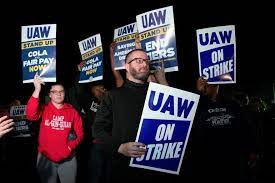"What Is the Typical Earnings of a UAW Autoworker?"
As the clock struck midnight on Thursday, the United Auto Workers initiated a strike against Detroit's prominent trio of automakers, the Big Three, grappling with a substantial impediment during what had been a contentious series of negotiations: compensation.
Ford, General Motors, and Stellantis (formerly known as Fiat Chrysler) had engaged in extensive deliberations with the UAW, scrutinizing the intricacies of a fresh labor agreement that carried substantial ramifications for the American automotive sector. UAW President Shawn Fain fervently advocated for substantial wage hikes, underscoring the fact that these automotive giants had amassed billions in profits while considerably augmenting CEO remuneration in recent years.
What constitutes the average remuneration for an American autoworker?
In essence, laborers on the factory floor operate under an hourly wage structure rather than a salaried one. On average, American autoworkers manning the manufacturing assembly lines garnered an approximate sum of $28 per hour this August, marking a $1 increment from the preceding year, in accordance with statistics proffered by the Bureau of Labor Statistics.
Compensation for individual auto workers exhibits variability contingent on their duration of service with a given automaker. Within the industry's tiered remuneration framework, recently hired personnel commence their employment at reduced pay scales relative to their more seasoned counterparts.
Employees categorized as top-tier, signifying those who embarked upon their professional journey with these companies prior to 2007, typically command an average hourly wage of approximately $33, as elucidated in contract summaries pertaining to the Big Three. Conversely, those recruited after 2007 are classified within the lower echelon, accruing wages that ascend incrementally at a rate of 6% on an annual basis in accordance with the terms delineated in the previous labor agreement, ultimately peaking at $17 per hour.
In contradistinction to their top-tier compatriots, lower-tier workers do not receive pension plans with clearly defined benefits, and their healthcare benefits are characterized by a diminished degree of generosity. The UAW membership body ardently advocates for the elimination of the two-tiered compensation system, asserting that it effectively relegates lower-tier colleagues to a status akin to second-class citizens.
Factoring in adjustments for inflation, autoworkers have borne witness to a decline of 19.3% in the average remuneration they receive since the year 2008, as expounded upon by Adam Hersh, a senior economist affiliated with the progressive-leaning Economic Policy Institute. This diminishing trend is primarily attributable to the "concessions" that autoworkers were compelled to acquiesce to in the aftermath of the 2008 automotive industry crisis, including the suspension of cost-of-living adjustments, as Hersh articulated in a recent treatise.
What is the remuneration of the chief executives of the Big Three automotive conglomerates?
Jim Farley, the Chief Executive Officer at Ford, garnered total compensation amounting to $21 million in the preceding year, as reported by the Detroit News. Meanwhile, Carlos Tavares, the CEO of Stellantis, commanded a total remuneration package valued at $24.8 million, as attested by the Detroit Free Press. As for Mary Barra, the CEO of General Motors, her total pay for the year 2022 approximated nearly $29 million, as detailed in the reports disseminated by Automotive News.
Collectively, the remuneration afforded to the Chief Executive Officers presiding over the Big Three conglomerates underwent a substantial escalation, recording a remarkable ascent of 40% spanning the period from 2013 to 2022, in accordance with data emanating from the Economic Policy Institute.
In terms of income disparity, Mary Barra's compensation stands at 362 times the remuneration of the quintessential GM laborer, whereas Carlos Tavares's earnings surpass the typical worker's by a factor of 365, as per the company's declarations furnished to the Securities and Exchange Commission. Jim Farley, the CEO at Ford, occupies a relatively modest position in this context, drawing a wage 281 times greater than that of the typical Ford employee, as is discernible from the documents submitted in regulatory filings.





![Download: Melody - Faithful [Audio Mp3]](https://blogger.googleusercontent.com/img/a/AVvXsEgWs7QcwF0OB3MEgo4QOffLeDEeKGgsxp6xb7cGJSBVn-_Cq4XTeoKXLAWmLsKrW0EL7T-2mWfB9M_MXPB8x20PIiC-duJ8A_4AaeMp5eyLfVkaSGpvd287M4MQH15gyUeDD0-sjLDKq49_Qwep82mNdQmK3KKZ7wvI30C2el4h59vnfjCJNQyjpp9r=w72-h72-p-k-no-nu)

![[Music] Ramazani ft Youngkey - Fadi (prod. Mickenzy)](https://blogger.googleusercontent.com/img/b/R29vZ2xl/AVvXsEjsIKqNdkFaK_dxcE6lQlTTD4Wr4jrthqPLdv0IY5wtLgrY3aAbbpP0nt-LffDru2jRrzddIWnwm7QLJKCMHAbeT9l8cK4kFqqPtS5rFqnfI534W3VTufYo13LP4oIVim2VPZiwz1semOwMCQgdJoxURCk_8x2Zg7VF-YtyIpxxpHKi7bJvfMph7JLU/w72-h72-p-k-no-nu/IMG-20221222-WA0013.jpg)







0 Comments